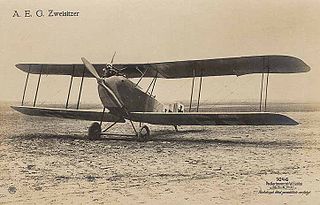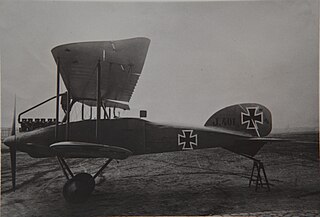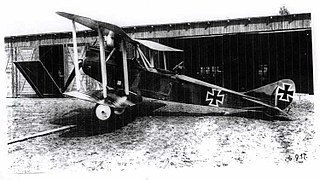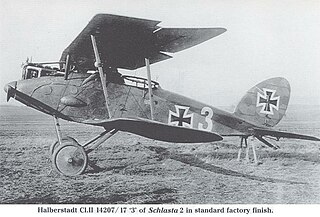| LVG C.V | |
|---|---|
 | |
| Role | Reconnaissance aircraft |
| National origin | Germany |
| Manufacturer | LVG (aircraft manufacturer) |
| First flight | 1917 |
The LVG C.V was a reconnaissance aircraft produced in large numbers in Germany during World War I. [1]
| LVG C.V | |
|---|---|
 | |
| Role | Reconnaissance aircraft |
| National origin | Germany |
| Manufacturer | LVG (aircraft manufacturer) |
| First flight | 1917 |
The LVG C.V was a reconnaissance aircraft produced in large numbers in Germany during World War I. [1]
The C.V was a conventional two-bay biplane design of its day, with unstaggered wings of equal span and tandem, open cockpits for the pilot and observer. [2] The ailerons, fitted only to the upper wing, featured aerodynamic balances that extended past the wingtips. [2] The fuselage was a semi-monocoque construction skinned in wood. [3]
Following the war, some C.Vs were used as civil transports, [1] while some 150 machines captured by Polish forces were put to use by the Polish army. [4] Other post-war users included Russia, Latvia, Lithuania, and Estonia; together operating about 30 aircraft. [4]
Latvian Air Force - Postwar
Lithuanian Air Force - Postwar
Polish Air Force - used as a reconnaissance aircraft during Polish–Soviet War, then in postwar service
Imperial Russian Air Service - Postwar[ citation needed ]
Data from Grosz 1998, 35
General characteristics
Performance
Armament

The AEG C.IV was a German two-seat biplane reconnaissance aircraft that entered service in 1916.

The Albatros C.III was a German two-seat general-purpose biplane of World War I, built by Albatros Flugzeugwerke. The C.III was a refined version of the successful Albatros C.I and was eventually produced in greater numbers than any other C-type Albatros.

The Albatros C.I,, was the first of the successful C-series of two-seat general-purpose biplanes built by Albatros Flugzeugwerke during World War I. Based on the unarmed Albatros B.II, the C.I reversed the pilot and observer seating so that the observer occupied the rear cockpit which was fitted with a ring-mounted 7.92 mm (0.312 in) Parabellum MG14 machine gun.

Friedrichshafen FF.49 was a German, two-seat, single-engine float-plane designed by Flugzeugbau Friedrichshafen in 1917.

The LVG C.VI was a German two-seat reconnaissance and artillery spotting aircraft used during World War I.

The Albatros C.VII was a German military reconnaissance aircraft which saw service during World War I. It was a revised and re-engined development of the Albatros C.V, which had proved disappointing in service.

The Albatros C.XII was a German military reconnaissance aircraft which saw service during World War I. It differed markedly from previous Albatros C-type aircraft by adopting an elliptical-section fuselage similar to that of the Albatros D.V. The C.XII also featured a tailplane of reduced area, but it retained the wings of the earlier Albatros C.X.

The Albatros C.XV was a German military reconnaissance aircraft developed during World War I. It was essentially a refinement of the C.XII, which had been put into production in 1918. The war ended before any examples became operational. However, some found their way into civilian hands and flew as transport aircraft in peacetime under the factory designation L 47. Others saw service with the air forces of Russia, Turkey, and Latvia.

The Albatros J.I was a German armored ground attack airplane of World War I, produced in 1918.

The Halberstadt C.V was a German single-engined reconnaissance biplane of World War I, built by Halberstädter Flugzeugwerke. Derived from the Halberstadt C.III, with a more powerful supercharged 160 kW (220 hp) Benz Bz.IVü engine, it saw service only in the final months of the war. Cameras were mounted in the observer's cockpit floor.

The Gotha G.IV was a heavy bomber used by the Luftstreitkräfte during World War I. It was the first mass-produced large airplane.

The Rumpler C.IV was a German single-engine, two-seat reconnaissance biplane. It was a development of C.III with different tail surfaces and using a Mercedes D.IVa engine in place of the C.III's Benz Bz.IV. The Rumpler 6B 2 was a single-seat floatplane fighter variant with a 120 kW (160 hp) Mercedes D.III engine built for the Kaiserliche Marine.

Entering service in 1915, the Rumpler C.I,, two-seater single-engine reconnaissance biplane, was one of the first German C-type aircraft, and also one of the longest serving in its class during World War I, being retired from the last front line units only in early 1918.

The DFW C.IV, DFW C.V, DFW C.VI, and DFW F37 were a family of German reconnaissance aircraft first used in 1916 in World War I. They were conventionally configured biplanes with unequal-span unstaggered wings and seating for the pilot and observer in tandem, open cockpits. Like the DFW C.II before them, these aircraft seated the gunner to the rear and armed him with a machine gun on a ring mount. Compared to preceding B- and C-class designs by DFW, however, the aerodynamics of the fuselage were more refined, and when coupled with more powerful engines, resulted in a machine with excellent performance.

The Halberstadt CL.II was a German two-seat escort fighter/ground attack aircraft of World War I. It served in large numbers with the German Luftstreitkräfte in 1917-18.
The Gotha G.VII. a.k.a.GL.VII, was a bomber aircraft produced in Germany during the final months of World War I. With the strategic bombing campaign effectively over, it was intended to be a high-speed tactical bomber with a secondary reconnaissance capability. It was a conventional two-bay biplane design with tractor-mounted engines, and a conventional empennage with twin fins and rudders. The bombardier's position in the nose of the aircraft that had featured on earlier Gotha designs was removed, and the nose of the aircraft severely truncated and fitted with a streamlined nose-cone. This allowed the engines to be located further inboard than on previous designs, bringing them closer to the aircraft's centreline and therefore minimising the effects of asymmetric thrust in the event of an engine failure. The engine nacelles also featured careful streamlining.

The LVG B.I was a 1910s German two-seat reconnaissance biplane designed by Luft-Verkehrs-Gesellschaft for the Luftstreitkräfte.

The LVG C.II was a 1910s German two-seat reconnaissance biplane designed at the Luft-Verkehrs-Gesellschaft for the Luftstreitkräfte.
The Sablatnig SF-5 was a reconnaissance seaplane produced in Germany during the First World War.
The LVG C.VIII was a prototype reconnaissance aircraft built in Germany during World War I.